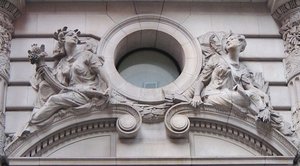Beaux-Arts architecture
|
|
Beaux-Arts architecture denotes the academic classical architectural style that was taught at the École des Beaux Arts in Paris, the home territory of this style, which influenced American architecture in the period 1885–1920. British architects of Imperial classicism followed a somewhat more independent course, owing to the cultural politics of the late 19th century. The phrase Beaux Arts is usually translated as "Fine Arts" in English.
The Beaux-Arts training emphasized the mainstream examples of Imperial Roman architecture between Augustus and the Severan emperors, Italian Renaissance and French and Italian Baroque models especially, but the training could then be applied to a broader range of models: Quattrocento Florentine palace fronts or French late Gothic. American architects of the Beaux-Arts generation often returned to Greek models, which had a strong local history in the American Greek Revival of the early 19th century. For the first time, repertories of photographs supplemented meticulous scale drawings and on-the-site renderings of details.
Beaux-Arts architecture depended on sculptural decoration along conservative modern lines, employing French and Italian Baroque and Rococo formulas combined with an impressionistic finish and realism. In the facade at right, Diana grasps the cornice she sits on in a natural action that is typical of Beaux-Arts integration of sculpture with architecture. Slightly overscaled details, bold scuptural supporting consoles, rich deep cornices, swags and sculptural enrichments in the most bravura finish the client could afford gave employment to several generations of architectural modellers and carvers of Italian and Central European backgrounds. A sense of appropriate idiom at the craftsman level supported the design teams of the first truly modern architectural offices.
Some aspects of Beaux-Arts approach could degenerate into mannerisms. Beaux-Arts training made great use of agrafes, clasps that links one architectual detail to another; to interpenetration of forms, a Baroque habit; to "speaking architecture" (architecture parlante) in which supposed appropriateness of symbolism could be taken to literal-minded extremes.
Beaux-Arts training emphasized the production of quick conceptual sketches, highly-finished perspective presentation drawings, close attention to the program, and knowledgeable detailing. Site considerations tended towards social and urbane contexts.
The first American architect to attend the École des Beaux-Arts was Richard Morris Hunt, followed by Charles Follen McKim. They were followed by an entire generation. Henry Hobson Richardson absorbed Beaux-Arts lessons in massing and spatial planning, then applied them to Romanesque architectural models that were not characteristic of the Beaux-Arts repertory. His Beaux-Arts training taught him to transcend slavish copying and recreate in the essential, fully digested and idiomatic manner of his models. Richardson evolved a highly personal style (Richardsonian Romanesque) freed of historicism that was influential in early Modernism.
The "White City" of the World's Columbian Exposition of 1893 in Chicago was a triumph of the movement and a major impetus for the short-lived City Beautiful movement in the United States. Beaux-Arts city planning, with its Baroque insistence on vistas punctuated by symmetry, eye-catching monuments, axial avenues, uniform cornice heights, a harmonious "ensemble" and a somewhat theatrical nobility and accessible charm, embraced ideals that the ensuing Modernist movement decried or just dismissed.
Beaux-Arts architecture, in spite of its insistence on exterior symmetry, was generally user-friendly. It embodied more sophisticated patterns of circulation and differentiated usage than its modernist critics allowed. Grand entrance and stairway sequences, borrowed from Baroque palace designs, had functional clarity: though visitors were impressed, they were rarely trapped or disoriented by ambiguities.
The Beaux-Arts style was also flexible. Steel-frame construction and other modern innovations in engineering techniques and materials, like structural Guastavino tile, were embraced by Beaux-Arts trained designers: splendid examples are provided by a string of Beaux-Arts urban railroad stations that combined many of these features within a triumphalist civic presentation. (Chicago's Union Station is a famous American example of this style.) Two of the best American examples of the Beaux-Arts tradition stand within a few blocks of each other: Grand Central Terminal and the New York Public Library.
External links
Further reading
- Reed, Henry Hope and Edmund V. Gillon Jr. 1988. Beaux-Arts Architecture in New York: A Photographic Guide.
Dover Publications: Mineola NY

